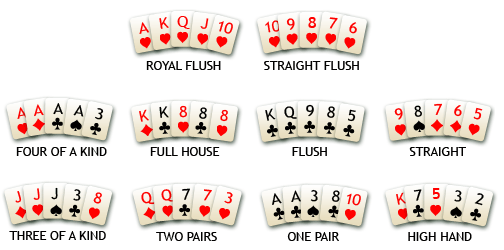Photo: This picture demonstrates, from left to right on each row, the order of hand superiority, with the top left image depicting the best hand in poker: a royal flush. It is crucial during play to be aware at all times of how your hand ranks, then make your bets accordingly. Courtesy of www.learn-texas-holdem.com.
- Daniel “Kid Poker” Negreanu is a good player to watch if you want to learn how to “read” other players. Photo courtesy of onlinepoker.net.
- Television programs like High Stakes Poker cover cash games with professional players, revealing hold cards to viewers so that they can up their own games. Photo courtesy of highstakespoker.org.
- A common sight when watching The Poker Brat Phil Hellmuth play is this disdainful look, which can also be a “tell” for his future play. Photo courtesy of onlinepoker.net.
So you want to learn how to play Holdem poker, or understand how the good ones get so good? We may not be Phil Ivey, but we do have a few pointers for you.
Poker began in the 1800’s, and at the turn of the next century, Texas Holdem (or Hold ‘em) was incarnated. Whether you call it Texas Holdem or just plain Holdem, it’s the same game – whereby each player is dealt two hold cards face down, and everyone shares five community cards, dealt face up: three at first (the flop), then the fourth (the turn), then the fifth (the river).
There are many internationally-renowned poker organizations and Holdem tournaments. The World Series of Poker held its first Main Event in 1970, and the following year, Johnny Moss won the big $30,000 prize playing no limit Holdem against 5 other entrants who’d each paid a $5k buy-in to play. The WSOP is today an entirely different animal, with thousands of entrants, a $10k buy-in, constant television coverage, and a first prize of several million dollars, varying with the number of entrants each year. The biggest Main Event to date happened during poker’s heyday in 2006, when there were 8,773 players and Jamie Gold took home a first prize of $12 million.
Whether you’re looking to pick up a new hobby or to improve your game, the best way to do so is to play. Poker classes offered at the Y or elsewhere teach you that you need to get in the game to be able to play it. While www.wsop.com and various other sites offer free tutorials, the classes (in which you have actual practice games), or casual games with family and friends who know what they’re doing, is the best way to start.

Common All-in Hand Match Ups and the Approximate Probabilities. Credit: Information found on pokerlistings.com
The reasons for playing with other people, live, are many. Perhaps most importantly, there is a specific order of dealing and of play, and an etiquette that needs to be adhered to. One of the crutches that inexperienced online players lean on is that the computer or your smartphone tells you when it’s your turn and doesn’t allow you to act out of turn or accidentally display your cards to a neighboring player. Doing so can alter the game in catastrophic ways. Nonetheless, supplementing live play with the occasional online game, especially if the stakes are low or nonexistent, is a good way to get experience.
Online players who are successful will find a completely different scenario when playing against real people. Not only are you sending information to other players about the cards you hold, but they are sending information to you, and you must learn to pay attention to it. These are the famous “tells” that everyone talks about. Good players don’t send out too many of them, and they’re able to quickly observe and learn the signals others are putting out. Men have claimed that women get erect nipples when on a good hand. (Suggestion to the men: don’t look there unless you want to get slapped. Suggestion to the women: wear padding or thicker clothes.) Often, players think that wearing hoods (Phil “Unabomber” Laak), sunglasses, hats, and crazy beards (Chris “Jesus” Ferguson) or crazy eyewear (Greg Raymer) will distract other players and/or cover up the big reveal that their eyes would otherwise display. Some players talk too much; others get quiet when they’re rolling good. Some players are just plain nasty when they lose (Phil “Poker Brat” Hellmuth) and others are constant gentlemen as the day is long (Doyle “Big Papa” Brunson). This writer’s favorite poker player is Daniel “Kid Poker” Negreanu, a six-time WSOP bracelet winner and arguably the best poker “read” alive.
It’s important to observe players who’ve been successful at the game and see how they do it. If it’s someone you know, fine, but it’s probably easier to go online or turn on ESPN and watch a few tournaments. Pick a player whose style you like and watch him or her closely over the course of one or more tournaments. A seemingly boring practice at first, it is extremely informative and can become as exciting as watching the NCAA finals.
It may be hard to make the transition from playing with friends or online to sitting down at a real live Holdem game. After a few months of playing casually, this writer made her live game debut in Las Vegas at the MGM Grand Hotel. With hands shaking like a hairless dog in the rain, she managed to pull in a couple of hundred dollars. You have to start somewhere.
The best advice we can give you, based on years of experience: do not become emotionally invested. If it takes never playing for money, or only playing limit games (where the betting is capped at the flop, turn, and river), or taking a beta blocker before the game (we’re kidding), it is imperative that you don’t become affected by the up-and-down swings that inevitably come with winning and losing at this thrillingly enjoyable game. The only way to pull in the chips is to wear your poker face inside and out.
By Eugénie Bisulco eugenie@theforumnewsgroup.com




